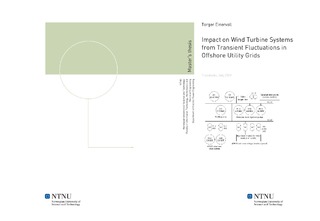Impact on Wind Turbine Systems from Transient Fluctuations in Offshore Utility Grids
Master thesis
Permanent lenke
http://hdl.handle.net/11250/256654Utgivelsesdato
2009Metadata
Vis full innførselSamlinger
- Institutt for elkraftteknikk [2468]
Sammendrag
Gas turbines in offshore power systems contribute to about 23% of Norway’s total emissions of CO2. One method for reducing these emissions could be the addition of wind turbines to the offshore utility grids. Power from shore is another alternative, but has been proven costly due to long cables and expensive HVDC converter stations. In this thesis work, the behaviours of different wind turbine technologies during transient fluctuations in an offshore utility grid have been studied. For this purpose, a dynamic model for an offshore oil platform was developed. Models of squirrel cage and doubly fed induction generator based turbines were developed as well. None of the modelled generators experienced problems with the disturbances caused by the electromechanical transient fluctuations. Based on the behaviour of the DFIG’s grid side converter, it is believed that the result would be the same for a wind turbine with full frequency conversion. Variable speed wind turbines are expected to remain controllable throughout electromechanical transient fluctuations such as for the simulated case. However, the controllers, converters and equipment have to be designed while bearing these fluctuations in mind. The controllability of the variable speed wind turbines could be used to contribute to voltage control by production and consumption of reactive power. A controller scheme with the purpose of stabilising the voltage at the gas turbine generators’ terminal was developed, but had low impacts on the power system behaviour. A stator flux feed forward term for the speed controller was developed. The term stabilised the power output of the doubly fed induction generator. However, the impact on the power system’s frequency response was minimal, and there is probably no material value of such an addition to the control loop.
